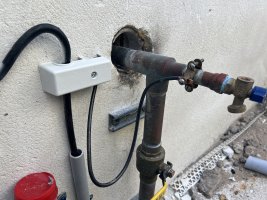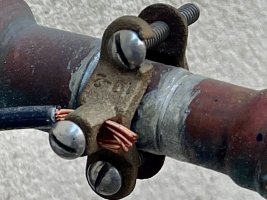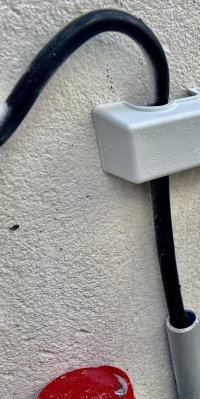-
Welcome to The Building Code Forum
Your premier resource for building code knowledge.
This forum remains free to the public thanks to the generous support of our Sawhorse Members and Corporate Sponsors. Their contributions help keep this community thriving and accessible.
Want enhanced access to expert discussions and exclusive features? Learn more about the benefits here.
Ready to upgrade? Log in and upgrade now.
You are using an out of date browser. It may not display this or other websites correctly.
You should upgrade or use an alternative browser.
You should upgrade or use an alternative browser.
Bonding of water pipe 600A service for SFR
- Thread starter jar546
- Start date
600 amp service, water pipe bonding jumper has to be sized per table 250.102(C)(1) per 250.104(A)(1) - 2/0 or 3/0 depending on 75 degrees C or 90 degrees C.
Also the water pipe bonding jumper can't go to the IBT since that is not on the list in 250.104(A)(1).
Also the water pipe bonding jumper can't go to the IBT since that is not on the list in 250.104(A)(1).
Last edited:
Also, as has been debated here before, some people would require the bonding connection to be on the interior of the building within 5' of the entrance of the water pipe per 250.68(C), since they would consider the water pipe shown here to be a grounding electrode that has to be bonded per 250.50.
Genduct
REGISTERED
I don't believe that a waterpipe is allowed to be thee Main Ground, (You need those ground rods or the wire in the concrete footings or the steel building) so that this water pipe ground serves the same purpose that grounding the Nat Gas Pipe i.e make sure that the occupants are safe when the hot shorts to that water or gas pipe and YOU DON'T become the Path to GroundAlso, as has been debated here before, some people would require the bonding connection to be on the interior of the building within 5' of the entrance of the water pipe per 250.68(C), since they would consider the water pipe shown here to be a grounding electrode that has to be bonded per 250.50.
Of course I am just a Carpenter, sticking my 2 cents into Electrical questions SO go easy on me
Does the contact surface of the clamp need to be bright & shiny?I would ask for bright, shiny metal pipe under a clamp with 3/0 copper or 250kcml aluminum GEC. (Table 250.66)
Unsupported cable length too long?What violation is this? #4 to water pipe
That’s hard to prove. There can’t be anything that impedes the flow of electricity. Tarnished copper might be a fine conductor….a coating of built up pollution, not so much…..and there is no doubt about shiny copper.Does the contact surface of the clamp need to be bright & shiny?
There is a list of items that can be used as a grounding electrode in 250.52, which includes ground rods, the ufer/concrete encased electrode, and various other items including a metal water pipe that is in contact with the earth for at least 10'. Every grounding electrode on the list needs to be supplemented with another electrode (such as a ground rod), except for the concrete encased electrode which is considered to be a good enough ground by itself.I don't believe that a waterpipe is allowed to be thee Main Ground, (You need those ground rods or the wire in the concrete footings or the steel building) so that this water pipe ground serves the same purpose that grounding the Nat Gas Pipe i.e make sure that the occupants are safe when the hot shorts to that water or gas pipe and YOU DON'T become the Path to Ground
Of course I am just a Carpenter, sticking my 2 cents into Electrical questions SO go easy on me
So, if you want to use one main water pipe and one ground rod, for example, as your "Main Ground", that would comply with the National Electric Code. We rarely go that route any more since the concrete encased electrode is so easy and cheap, but it is an option.
250.52 lists all of the possible grounding electrodes. If any are present they shall be used as an electrode. Metal underground water pipe shall be supplemented with another electrode.
A single rod, pipe, or plate electrode shall be supplemented by an additional electrode of a type specified in 250.52(A)(2) through (A)(8).
Exception: If a single rod, pipe, or plate grounding electrode has a resistance to earth of 25 ohms or less, the supplemental electrode shall not be required.
There is a whole lot more to know about the grounding electrode system.
A single rod, pipe, or plate electrode shall be supplemented by an additional electrode of a type specified in 250.52(A)(2) through (A)(8).
Exception: If a single rod, pipe, or plate grounding electrode has a resistance to earth of 25 ohms or less, the supplemental electrode shall not be required.
There is a whole lot more to know about the grounding electrode system.
jar546
CBO
This is where the water enters the building. South Florida, no freezing tempsAlso, as has been debated here before, some people would require the bonding connection to be on the interior of the building within 5' of the entrance of the water pipe per 250.68(C), since they would consider the water pipe shown here to be a grounding electrode that has to be bonded per 250.50.
jar546
CBO
What you can't see is that there are 2 ground rods, bonding to the water service, bonding to building steel. The issue posted was specific to the bond of the water service pipe.250.52 lists all of the possible grounding electrodes. If any are present they shall be used as an electrode. Metal underground water pipe shall be supplemented with another electrode.
A single rod, pipe, or plate electrode shall be supplemented by an additional electrode of a type specified in 250.52(A)(2) through (A)(8).
Exception: If a single rod, pipe, or plate grounding electrode has a resistance to earth of 25 ohms or less, the supplemental electrode shall not be required.
There is a whole lot more to know about the grounding electrode system.
It is pacifically wrong.What you can't see is that there are 2 ground rods, bonding to the water service, bonding to building steel. The issue posted was specific to the bond of the water service pipe.
Last edited:
Mr. Inspector
SAWHORSE
A new service for a old cottage that sits on blocks ( built before codes). Grounding system was connected to a rod and a water pipe. I looked under the cottage and there was 6 other old copper pipes sticking out of the ground but not going up into the floor. Owner said every time a pipe froze and broke a new water pipe was run. Code says all electrodes that are present at each building or structure served shall be bonded together to form the grounding electrode system.
Are they required to bond all of these old pipes together with the grounding electrode system?
Are they required to bond all of these old pipes together with the grounding electrode system?
I would say that the old pipes are auxiliary electrodes under 250.54, and therefore do not have to be bonded together under 250.50, since 250.54 specifically nullifies 250.50.
However, there are others here who disagree that those pipes are auxiliary, and there really can be no resolution because there is no definition of "auxiliary electrode". There is a thread on this subject where we beat it entirely to death, https://www.thebuildingcodeforum.com/forum/threads/water-main-yes-or-no.30417/post-235253).
So you get to pick, lol.
However, there are others here who disagree that those pipes are auxiliary, and there really can be no resolution because there is no definition of "auxiliary electrode". There is a thread on this subject where we beat it entirely to death, https://www.thebuildingcodeforum.com/forum/threads/water-main-yes-or-no.30417/post-235253).
So you get to pick, lol.
Last edited:
The old pipes no longer serve the cottage, therefore they don’t need to be bonded.all electrodes that are present at each building or structure served



